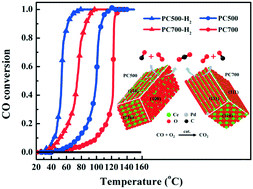Effect of exposed facets and oxygen vacancies on the catalytic activity of PdxCe1−xO2−δ catalysts: a combined experimental and theoretical study†
Abstract
The effect of exposed facets and oxygen vacancies on the catalytic activity of PdxCe1−xO2−δ nanorods for low-temperature CO oxidation has been investigated based on both experimental and theoretical methods. PdxCe1−xO2−δ nanorods with exposed {100} and {110} facets are more active than those with the {111} facet, and such superior active facets can become selectively accessible by modulating the calcination temperature. Moreover, a post H2 reduction process further enhances the low temperature activity of PdxCe1−xO2−δ composites with a CO initial conversion temperature as low as 24 °C. It is suggested that the enhanced activity by the H2 reduction process is mostly attributed to the promotion of oxygen vacancy concentration on the exposed facets. This is in reasonable agreement with the theoretical prediction that the CO oxidation proceeds via an oxygen vacancy-mediated Eley–Rideal mechanism on PdxCe1−xO2−δ nanorods. Our work highlights the importance of both exposed facets and oxygen vacancies on low temperature CO oxidation for PdxCe1−xO2−δ nanorod catalysts.



 Please wait while we load your content...
Please wait while we load your content...